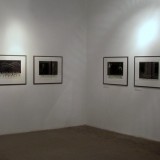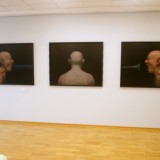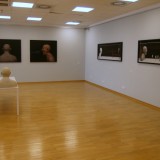Grzegorz Przyborek
Born in 1949. An artist working in the media of photography, drawing, sculpture and installation art. He is also a photography theorist. A graduate of the Art College in Łódź (since 1996 renamed the Academy of Fine Arts), he received his diploma in 1974 and since 1976 has worked in the Art College in Łódź (since 1994 as a professor). He manages the Photography Studio in the Multimedia Faculty. He is also a lecturer at the Film School in Łodź and the Warsaw School of Photography and previously he also lectured at the Art University (and Academy of Fine Arts) in Poznań. Since 1988 he has been a member of the Polish Association of Artist Photographers. His works are in the collections of: the Art Museum in Łódź, the National Museum in Wrocław, Museum of Ziemia Lubuska in Zielona Góra, Stadtmuseum Gross-Gerau, Collectiones des Artotheques “Photographie d'Auteur”, Lyon; Promocje Broncolor, Switzerland; Promocja Radici-Group, Bergamo, Fond National d'Art Contemporain (FNAC), France; Dolnośląskie Towarzystwo Zachęty Sztuk Pięknych, Wrocław; Wielkopolskie Towarzystwo Zachęty Sztuk Pięknych, Poznań.
After graduation he consciously resigned from the process of creating graphics in favour of photography. In the late 70s he created a semi-documental series with an expressed feeling of sadness and melancholy entitled Piotrkowska St. – gates and display windows in which, using a strong retouch technique he consciously weakened the form of a document. From the 80s there comes a poetic series using a collage technique such as Intimate landscape (1981/2) and Objects and paintings (1984). In the second half of the 80s he created more and more staged photographs plus sculptural objects also used in photography but treated autonomously.
During the exhibition Polish intermedia photography of the 80s (presented at the BWA Gallery, Poznań, 1988) the artist showed one his most interesting works – an installation in which he used prepared feathers, photos and stones, entitled January, February, March… which was devoted to the non-material aspects of flying. His original, style of staged photography was shaped in the late 80s. Proof of that is a series entitled Impossible objects which used certain achievements of photo-medialism in order to cause illusions of perspective which had an oniric and poetic hidden meaning.
Impossible objects (1989) and in particular Memories from Arles (1991) are both examples of very original staged photography. The type of photography was shaped based on onirism (a post-surrealistic effect) and a search for the paradoxes within our perception. This includes above all, an illusionism which results from an exaggeration and foreshortening of perspective, which was one of the most important rules in modernist photography since the end of the 20th century and has been developing until now. A photograph entitled A very light French breakfast which became one of the most popular artworks by Przyborek and belonged to the second series proved his subtle sense of irony and perfect style.
In the 90s, Grzegorz Przyborek’s style of photography took a new direction, continuing however his earlier achievements from the second half of the 80s. Many photographs are reminiscent of his surreal inspirations(for example Man Ray) plus mainly “surreal objects”. A yearly scholarship sponsored by the French government in the School of Photography in Arles in 1990 had a great impact on the artist’s work during that period. The artist attaches a lot of importance to initially making a very faithful drawing and then in a verist way, photographing most often complicated arrangements comprising of objects, ropes, stones etc.
The series entitled Civilisations (1992-93) and Europa Hotel are his personal interpretation of political events (the collapse of Yugoslavia and the resulting genocide) plus his belief in the possibility of the spiritual salvation of art and the world. This can be seen especially in the work Maintainting sense of the Creation of the World (1994) which has a para-religious meaning, with an image of a hand in the centre and reminiscence of a disappearing Crucifixion, which is a symbol of Christianity. In 1996 he created a series entitled Thanatos (in both a black and white and colour photography version) which illustrated a universal sign of death, but with hidden personal references, in the shape of three-dimensional sculptures exhibited together with photographs. Death appeared in a male and female form of a more or less demonic mannequin, also with references to modernist ideas.
In the first decade of 21st century he created just a few works. The most important is the series Cantus lamentus (2010) in which the artist continues to warn against growing dehumanisation and infatuation with pop culture. His art was confronted by similar artists during the exhibition Archetype of photography. Joachim Froese, Ken Matsubara, Grzegorz Przyborek (CCA Łaźnia, Gdańsk 2010). The artist said about the role and specifics of the medium of photography: Photography gave me the possibility of relating to a world which exists independently, through another dimension and time. Colloquially one says that photography is a mirror of reality or its reflection, but that would mean treating it literally. In my opinion it has nothing to do with reality as we perceive it. Photography gave us a freedom the possibility of using 3D elements or real elements in space, which is in my understanding, the staging and creating of a certain sphere of expression, free from manual gesture or the trace that an artist leaves on a painting.1
While analysing Przyborek’s output in drawing, sculpture or the final effect of his work – that is “staged photography” (on the border of photography, drawing and sculpture) I think that the most interesting elements are the photographs in which 3D sculptures are connected with problems of a specifically photographic nature (light, foreshortening of perspective, illusionist effects). Since late 90s the artist occasionally produces computer graphics which continue his photographic concerns. In his artistic development very important times were the 90s, when the artist revived Mediterranean religious myths making reference to the most important ethical and philosophical issues.
1. G. Przyborek [in conversation with K. Jurecki], in: K. Jurecki and K. Makowski,Słowo o fotografii, Łódź 2003, 212.
Krzysztof Jurecki
more at the artist's web site:
http://przyborek.toya.net.pl/





